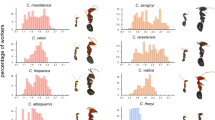Abstract
We consider a matrix model to describe the population dynamics of the Indian paper waspRopalidia marginata, a eusocial insect species of peninsular India. We obtain the stable class distribution of this model and apply it to compute the worker-brood genetic relatedness of the colony. Our results are compared with those obtained by observational studies. Further, we study the effect of changes in turnover rates and survival rates on the genetic relatedness coefficient with the help of the theoretical formulae.
Similar content being viewed by others
References
Gadagkar R., Gadgil M., Joshi N. V. and Mahabal A. S. 1982 Observations on the natural history and population ecology of the social waspRopalidia marginata (Lep.) from peninsular India (Hymenoptera: Vespidae).Proc. Indian Acad. Sci. (Anim. Sci.) 91: 539–552
Gadagkar R. 1985 Evolution of insect sociality—A review of some attempts to test modern theories.Proc. Indian Acad. Sci. (Anim. Sci.) 94: 309–324
Gadagkar R. 1985 Kin recognition in social insects and other animals—A review of recent findings and a consideration of their relevance for the theory of kin selection.Proc. Indian Acad. Sci. (Anim. Sci.) 94: 587–621
Gadagkar R., Chandrashekara K., Chandran S. and Bhagvan S. 1991 Worker-brood genetic relatedness in a primitively eusocial wasp (a pedigree analysis).Naturwissenschaften 78: 523–526
Gadagkar R., Chandrashekara K., Chandran S. and Bhagvan S. 1993 Serial polygyny in primitively eusocial waspRopalidia marginata: implications for the evolution of sociality. InQueen number and sociality in insects (ed.) L. Keller (Oxford: Oxford University Press)
Hamilton W. D. 1964a The genetical evolution of social behaviour I.J. Theor. Biol. 7: 1–16
Hamilton W. D. 1964b The genetical evolution of social behaviour II.J. Theor. Biol. 7: 17–52
Karlin S. and Taylor H. M. 1981A second course in stochastic processes (New York: Academic Press)
Lancaster P. and Tismenetsky M. 1985The Theory of matrices, 2nd edn (New York: Academic Press)
Muralidharan S., Shaila M. S. and Gadagkar R. 1986 Evidence of multiple matingin the primitively eusocial waspRopalidia marginata (Lep.) (Hymenoptera: Vespidae).J. Genet. 65: 153–158
Oster G. F. and Wilson E. O 1978Caste and ecology in the social insects (Princeton: Princeton University Press)
Author information
Authors and Affiliations
Rights and permissions
About this article
Cite this article
Haridas, C.V., Rajarshi, M.B. On computing worker-brood genetic relatedness in colonies of eusocial insects: A matrix model. J. Genet. 76, 43–54 (1997). https://doi.org/10.1007/BF02931768
Received:
Revised:
Issue Date:
DOI: https://doi.org/10.1007/BF02931768




